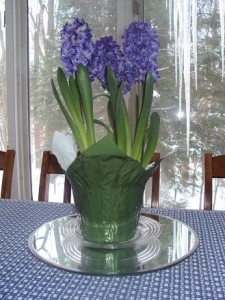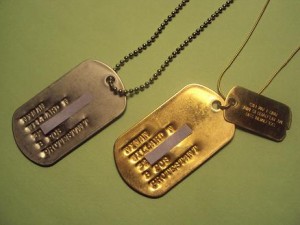I’ve always loved the BBC comedy show “Keeping Up Appearances.” In the Chicago area, it played at 7:30 pm every Saturday night. My mom also loved this program, especially the hilarious character at the center of every episode, Hyacinth Bucket, “…pronounced ‘Bou-quet’!”
For a year or so before Mom died, Nate graciously volunteered to eat Saturday evening dinners with his newspapers instead of his wife, letting me spend that weekly time with Mom in her apartment. I made dinner for the three of us, then packed up two plates to take to Mom’s, leaving Nate’s with him.
Every week Mom and I eagerly anticipated Saturday’s dinner-date with each other and “our Hyacinth”, laughing together over her misguided efforts to keep up with the Joneses and hopefully surpass them. If there was anything redeeming about that show, it was learning how not to act, but Mom and I had a delightful time watching Hyacinth scheme and dream.
As for Hyacinth’s name sake, a colorful spring bulb-flower, they’ve always been my favorites. Last Saturday Mary stepped into our door carrying a pot full of them, three hyacinths just on the verge of bursting into bloom. This early preview of spring would soon give off a rich perfume strong enough to fill the room. Even with my damaged olfactory nerves, I could smell trace amounts of their powerful scent, a rare treat.
This morning when I came downstairs, all three blooms had opened to-the-max. They were so lush an d heavy, their stems were bent sideways. I rushed over and buried my nose in them, enjoying a spring moment in the middle of January, courtesy of my thoughtful sister.
d heavy, their stems were bent sideways. I rushed over and buried my nose in them, enjoying a spring moment in the middle of January, courtesy of my thoughtful sister.
Standing back to admire the hyacinths, I could see they needed more support than their hollow stems were offering. It was a picture of how I felt on many mornings, too, hollow and heavy. Finding an old garden stake in the basement corner, I snapped it in three pieces and gave them the support they needed. Problem solved.
It got me thinking about my situation. What is my garden stake?
I didn’t have to think long. The number one thing shoring me up when I’ve felt limp and low has been prayer, especially prayer that includes the words of Scripture. Praying by using verses of the Bible is my fail-safe way to claim the support and vigor God offers. On a really burdensome day, I can put my name right into the passage as I pray it. God doesn’t mind. After all, his promises are for each of us personally.
Praying through 1 Peter 5:7-9 has encouraged me today: “I’m casting all my worries and concerns on you, Lord, because you promise you’ll care for me. I’m asking you to keep me alert to the evil you tell me is prowling around like a wild animal. The devil wants to spoil my reliance on you as I try to get through this grief. Strengthen me to resist him and stand firm in my faith, knowing many others who trust you through tough times are doing exactly that, all over the world.”
The vivid word pictures of Scripture are helpful. Even today God delivered a fresh visual, the drooping hyacinths, to link me with the practical power in that 1 Peter passage. God was following through on his promise to care for me, reminding me of his provision within each day.
Although television’s Hyacinth demonstrated what not to do, nature’s hyacinth taught me to stay close to the strong stake of scriptural prayer. The results are more satisfying than even the best episode of “Keeping Up Appearances.”
“Three times I pleaded with the Lord about this [grief or pain], that it should leave me. But he said to me, ‘My grace is sufficient for you, for my power is made perfect in weakness.’ Therefore I will boast all the more gladly of my weaknesses, so that the power of Christ may rest upon me. For the sake of Christ, then, I am content with weaknesses… hardships… and calamities, for when I am weak, then I am strong.” (2 Corinthians 12:8-10)





